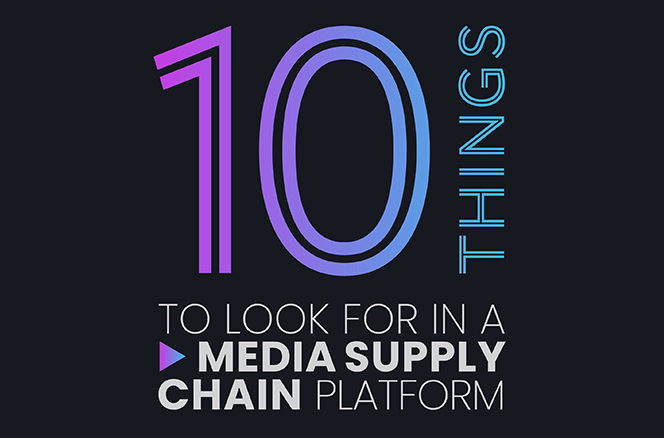Every media organization maintains an immense content archive, typically stored across multiple on-premises storage systems. Content that in many cases has been collected over decades, some of it in hard-to-retrieve formats, or worse, in systems that are no longer serviceable. To make matters worse, much of the content in most archives has limited descriptive and technical metadata, which makes finding specific pieces of content difficult, particularly if you want to search for anything (such as actors, locations, style, etc.) other than perhaps a simple title. If you can’t find the content you need, and you can’t access it from where it is stored, that content has lost all value.
Given how much value is locked up in most content archives, it only makes sense to rethink where those archives are located, and how the content is managed. Taking a practical perspective, maintaining multiple on-premises storage systems is time- and resource-consuming. From electrical power to HVAC to tape drive migrations, the cost to keep archive systems up and running is not insignificant (in addition to the cost of the raw hardware itself). Add in the difficulty of generating and managing the metadata needed to find and monetize content effectively, and it’s no wonder that many media companies are looking for better alternatives.
For these reasons, businesses are looking at whether the cloud is a better option for their content archives. The cloud offers highly efficient and resilient compute and storage resources, and as we’ve reported recently, mostly powered by renewable resources. The cloud also offers location independence and simultaneous accessibility by remote workers, making content more readily available to today’s distributed workforce.
But moving an archive to the cloud is about far more than just making a copy of your archive in Amazon S3. It represents a one-time opportunity to reset the why, what, and how content archives will be managed. As Dave Klee, vice president of strategic media solutions at A+E Networks, said in a presentation at the 2022 AWS re:Invent conference, “Moving an archive to the cloud is not a lift-and-shift proposition, but rather a rethinking of processes, software design, and even the content and how it’s structured and annotated to facilitate agile workflows. You’re touching that content, so take the opportunity to do something with it. Enrich the metadata you bring into the cloud with your archive, and you set yourself up to implement automation and processing at scale. You create more valuable assets and the foundation for responsive distribution going forward.”
Let’s look at how a modern media supply chain can facilitate intelligent movement of content to the cloud. As that shift takes place, transformation tools can be applied to put every piece of content in a consistent, modern format, update captioning, enhance audio, or augment language tracks. AI and ML tools can be applied to enrich metadata with details that describe what’s in the content itself, solving the classic problem of a massive volume of content, and little information about it. After all, content is hard to find if it is not well described, and if it’s hard to find, it’s hard to use. By normalizing and describing content as it moves to the cloud, you lay the groundwork to extract greater value out of it. (You can also identify and eliminate duplicate versions of content and reduce overall storage costs.)
“The need to move valuable archives off aging and proprietary tape-based systems into a secure and accessible digital environment is widely recognized, but the value that can be derived from cloud migration is often underestimated,” says Brian Campanotti, founder and CEO at Cloudfirst. “While preservation of legacy archive metadata throughout the migration process ensures closed-loop integration with key systems within the digital supply chain, the application of artificial intelligence to augment this metadata significantly increases the value of the archive, which becomes easier to manage and monetize.”
The very process of migrating and modernizing an archive in the cloud creates fresh opportunities to generate more value from your content. You’re enabling your business to leverage more of that content faster and more accurately because you have better information about the content itself. If you are looking for content that fits a particular theme or topic, you will be much more likely to find appropriate content that you might have missed before. Once you’ve migrated content to the cloud, you’re positioned to run supply chains that prepare and push that content to any of a variety of different distribution options.
Pushing content through a media supply chain is not limited to just new programs arriving on the virtual loading dock. Increasingly, the content flowing through supply chains is coming from the archive. Regardless of whether a show is new or comes from the archive, it needs to be processed and packaged so that it is ready for each distribution endpoint. A modern cloud-based media supply chain can accelerate and automate most of the work needed, giving media companies a competitive advantage when it comes to monetizing their content archives.
One such example is FAST channels, the subject of our recent post, “Improve Margins, Reduce Risk: Drive FAST Channel Content Prep With Your Optimized Media Supply Chain.” Media companies are using FAST channels to monetize their archives because this model allows them to create linear streams of thematic content built around content in their archives — the valuable assets and franchises they already own. Because you’re streaming from the cloud, you’re adhering to one of my favorite mantras: “Once in the cloud, stay in the cloud.”
In other words, with content in the cloud, you can do more, faster. And when that’s the case, you increase your revenue opportunity as well as your time to revenue. You can create promotional content with unprecedented speed, experiment with new distribution options, and meet tight fulfillment deadlines for new licensing deals. You can leverage your active, always-in-motion archive as an enabler of future business.
Ready to take a serious look at optimizing your content archive to unlock new revenue opportunities? Check out our new Archive Migration Solution Brief.



